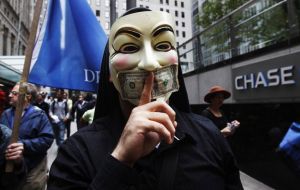MercoPress. South Atlantic News Agency
The ‘super-connected’ 1.318 corporations of global economic power
 The Occupy Wall Street movement and the complexity of reality
The Occupy Wall Street movement and the complexity of reality As protestors against financial power sweep the world this week, science may have confirmed the protesters' worst fears. An analysis of the relationships between 43.000 transnational corporations has identified a relatively small group of companies, mainly banks, with disproportionate power over the global economy.
The study's assumptions have attracted some criticism, but complex systems analysts contacted by New Scientist say it is a unique effort to untangle control in the global economy. Pushing the analysis further, they say, could help to identify ways of making global capitalism more stable.
The idea that a few bankers control a large chunk of the global economy might not seem like news to New York's Occupy Wall Street movement and protesters elsewhere. But the study, by a trio of complex systems theorists at the Swiss Federal Institute of Technology in Zurich, is the first to go beyond ideology to empirically identify such a network of power. It combines the mathematics long used to model natural systems with comprehensive corporate data to map ownership among the world's transnational corporations (TNC).
“Reality is so complex, we must move away from dogma, whether it's conspiracy theories or free-market,” says James Glattfelder. “Our analysis is reality-based.”
Previous studies have found that a few TNC own large chunks of the world's economy, but they included only a limited number of companies and omitted indirect ownerships, so could not say how this affected the global economy - whether it made it more or less stable, for instance.
The Zurich team can. From Oribs 2007, a database listing 37 million companies and investors worldwide, they pulled out all 43,060 TNC and the share ownerships linking them. Then they constructed a model of which companies controlled others through shareholding networks, coupled with each company's operating revenues, to map the structure of economic power.
The work revealed a core of 1.318 companies with interlocking ownerships. Each of the 1318 had ties to two or more other companies, and on average they were connected to 20. What's more, although they represented 20% of global operating revenues, the 1.318 appeared to collectively own through their shares the majority of the world's large blue chip and manufacturing firms - the “real” economy - representing a further 60% of global revenues.
When the team further untangled the web of ownership, it found much of it tracked back to a “super-entity” of 147 even more tightly knit companies - all of their ownership was held by other members of the super-entity - that controlled 40% of the total wealth in the network. “In effect, less than 1% of the companies were able to control 40% of the entire network,” says Glattfelder. Most were financial institutions. The top 20 included Barclays Bank, JPMorgan Chase & Co, and The Goldman Sachs Group.
John Drifill of the University of London, a macroeconomics expert, says the value of the analysis is not just to see if a small number of people control the global economy, but rather its insights into economic stability.
Concentration of power is not good or bad in itself, says the Zurich team, but the core's tight interconnections could be. As the world learned in 2008, such networks are unstable. “If one [company] suffers distress,” says Glattfelder, “this propagates.”
“It's disconcerting to see how connected things really are,” agrees George Sugihara of the Scripps Institution of Oceanography in La Jolla, California, a complex systems expert who has advised Deutsche Bank.
Yaneer Bar-Yam, head of the New England Complex Systems Institute (NECSI), warns that the analysis assumes ownership equates to control, which is not always true. Most company shares are held by fund managers who may or may not control what the companies they part-own actually do. The impact of this on the system's behavior, he says, requires more analysis.
Crucially, by identifying the architecture of global economic power, the analysis could help make it more stable. By finding the vulnerable aspects of the system, economists can suggest measures to prevent future collapses spreading through the entire economy. Glattfelder says we may need global anti-trust rules, which now exist only at national level, to limit over-connection among TNC. Sugihara says the analysis suggests one possible solution: firms should be taxed for excess interconnectivity to discourage this risk.
One thing won't chime with some of the protesters' claims: the super-entity is unlikely to be the intentional result of a conspiracy to rule the world. “Such structures are common in nature,” says Sugihara.
Newcomers to any network connect preferentially to highly connected members. TNC buy shares in each other for business reasons, not for world domination. If connectedness clusters, so does wealth, says Dan Braha of NECSI: in similar models, money flows towards the most highly connected members. The Zurich study, says Sugihara, “is strong evidence that simple rules governing TNC give rise spontaneously to highly connected groups”. Or as Braha puts it: “The Occupy Wall Street claim that 1% of people have most of the wealth reflects a logical phase of the self-organizing economy.”
So, the super-entity may not result from conspiracy. The real question, says the Zurich team, is whether it can exert concerted political power. Driffill feels 147 is too many to sustain collusion. Braha suspects they will compete in the market but act together on common interests. Resisting changes to the network structure may be one such common interest. (New Scientist).-




Top Comments
Disclaimer & comment rulesCommenting for this story is now closed.
If you have a Facebook account, become a fan and comment on our Facebook Page!